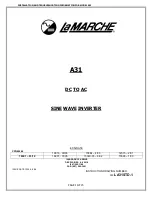
632
SIEPCYEUOQ2V01A Q2V Technical Manual
•
Motor thermal characteristics
•
Time characteristics
If the drive detects motor overload, the drive will trigger an
oL1 [Motor Overload]
and stop the drive output.
Set
H2-01 = 4E [NO,NC,CM FuncSelection = Drive PreOH]
to set a motor overload alarm. If the motor overload
level is more than 90% of the
oL1
detection level, the output terminal activates and triggers an overload alarm.
0 : Disabled
Disable motor protection when motor overload protection is not necessary or when the drive is operating more
than one motor.
Refer to
for an example of the circuit configuration to connect more than one motor to one drive.
Figure 12.107 Protection Circuit Configuration to Connect More than One Motor to One Drive
NOTICE:
When you connect more than one motor to one drive or when the motor amp rating is higher than the drive amp
rating, set L1-01 = 0 [Motor Cool Type for OL1 Calc = Disabled] and install thermal overload relays for each motor. The
electronic thermal protection of the drive will not function and it can cause damage to the motor.
1 : VTorque
Use this setting for general-purpose motors with a 60 Hz base frequency.
The overload tolerance decreases as motor speed decreases because the cooling fan speed decreases and the ability
of the motor to cool decreases in the low speed range.
The overload tolerance characteristics of the motor change the trigger point for the electronic thermal protector.
This provides motor overheat protection from low speed to high speed across the full speed range.
Load Tolerance
Cooling Capability
Overload Characteristics
(at 100% motor load)
This motor is designed to operate with commercial line
power. Operate at a 60 Hz base frequency to maximize
the motor cooling ability.
If the motor operates at frequencies less than 60 Hz, the
drive will detect
oL1
. The drive triggers a fault relay
output and the motor coasts to stop.
2 : CT 10:1 Speed Range
Use this setting for drive-dedicated motors with a speed range for constant torque of 1:10.
The speed control for this motor is 10% to 100% when at 100% load. Operating slower than 10% speed at 100%
load will cause motor overload.
Summary of Contents for Q2V Series
Page 2: ...This Page Intentionally Blank 2 SIEPCYEUOQ2V01A Q2V Technical Manual...
Page 12: ...12 SIEPCYEUOQ2V01A Q2V Technical Manual...
Page 18: ...i 2 Legal Information 18 SIEPCYEUOQ2V01A Q2V Technical Manual...
Page 26: ...1 2 Features and Advantages of Control Methods 26 SIEPCYEUOQ2V01A Q2V Technical Manual...
Page 38: ...2 8 Installation Methods 38 SIEPCYEUOQ2V01A Q2V Technical Manual...
Page 70: ...3 3 Main Circuit Wiring 70 SIEPCYEUOQ2V01A Q2V Technical Manual Models B006 B012...
Page 102: ...3 17 Motor Application Precautions 102 SIEPCYEUOQ2V01A Q2V Technical Manual...
Page 138: ...4 12 Test Run Checklist 138 SIEPCYEUOQ2V01A Q2V Technical Manual...
Page 144: ...5 2 European Standards 144 SIEPCYEUOQ2V01A Q2V Technical Manual...
Page 145: ...Standards Compliance 5 5 2 European Standards SIEPCYEUOQ2V01A Q2V Technical Manual 145...
Page 146: ...5 2 European Standards 146 SIEPCYEUOQ2V01A Q2V Technical Manual...
Page 266: ...7 10 Troubleshooting Without Fault Display 266 SIEPCYEUOQ2V01A Q2V Technical Manual...
Page 284: ...8 6 Storage Guidelines 284 SIEPCYEUOQ2V01A Q2V Technical Manual...
Page 312: ...10 10 Peripheral Devices and Options 312 SIEPCYEUOQ2V01A Q2V Technical Manual...
Page 430: ...11 21 Parameters Changed by PM Motor Code Selection 430 SIEPCYEUOQ2V01A Q2V Technical Manual...
Page 731: ...SIEPCYEUOQ2V01A Q2V Technical Manual 731 Z Z pulse Auto Tuning 125...
















































